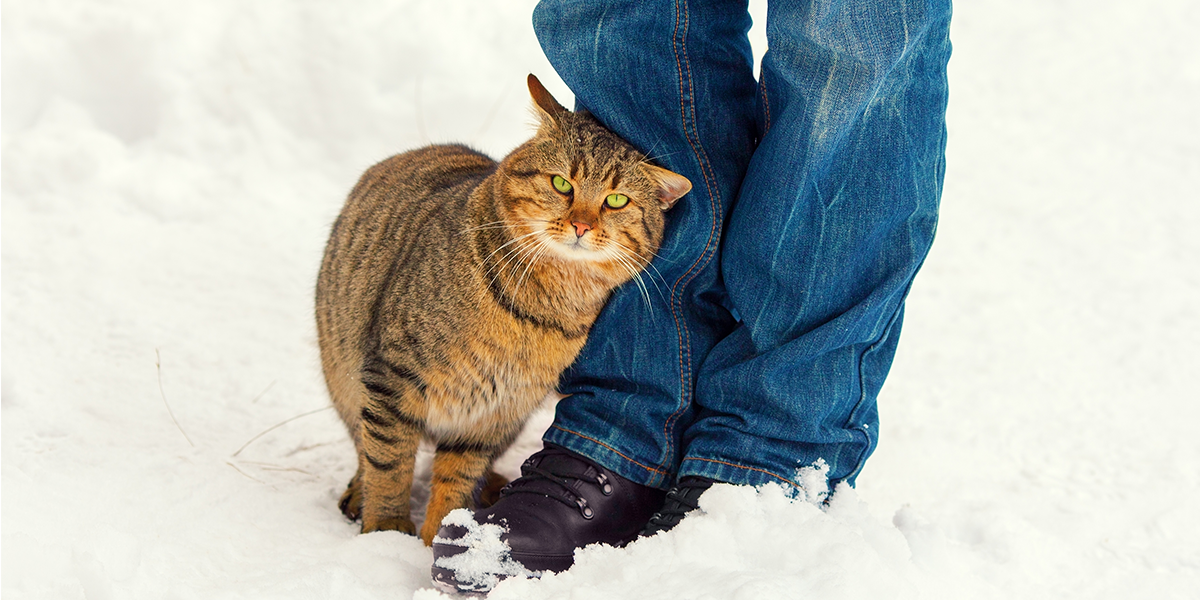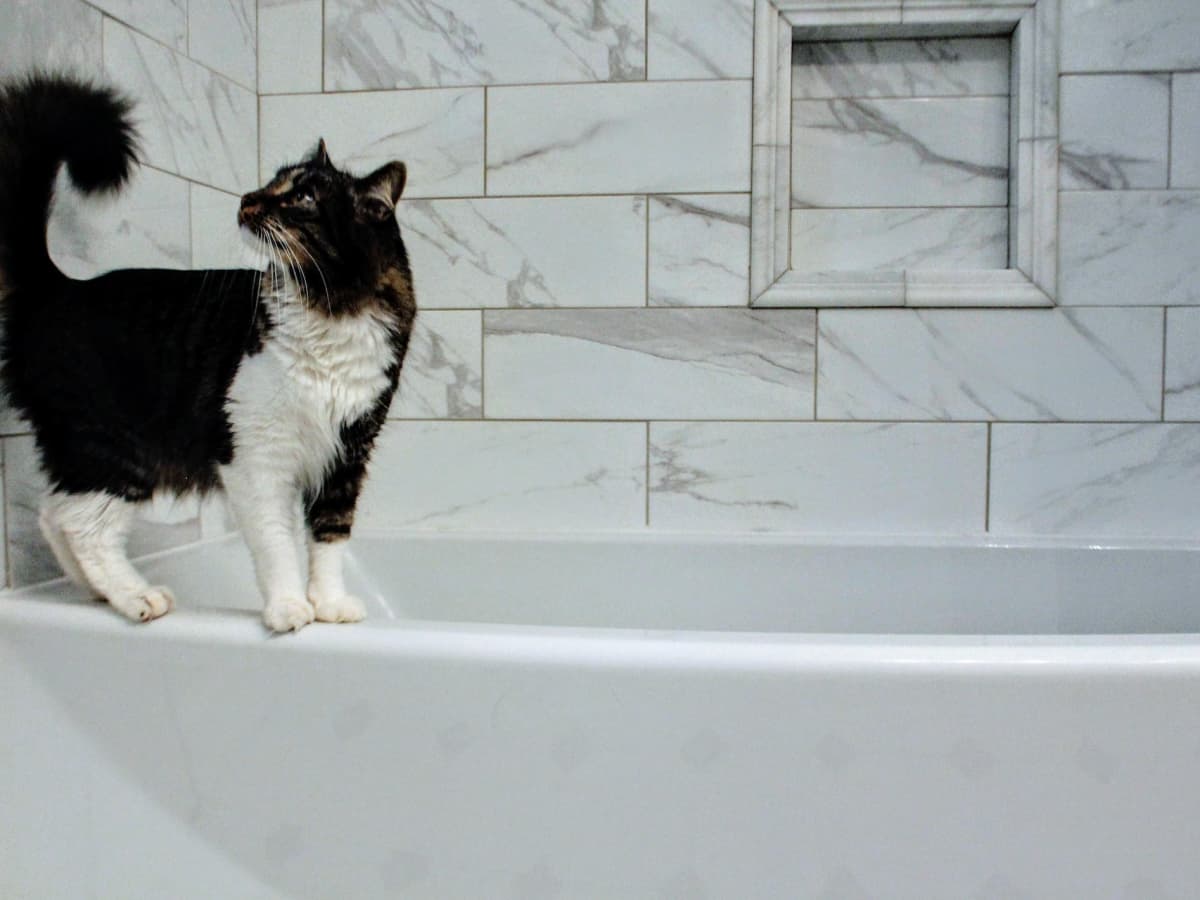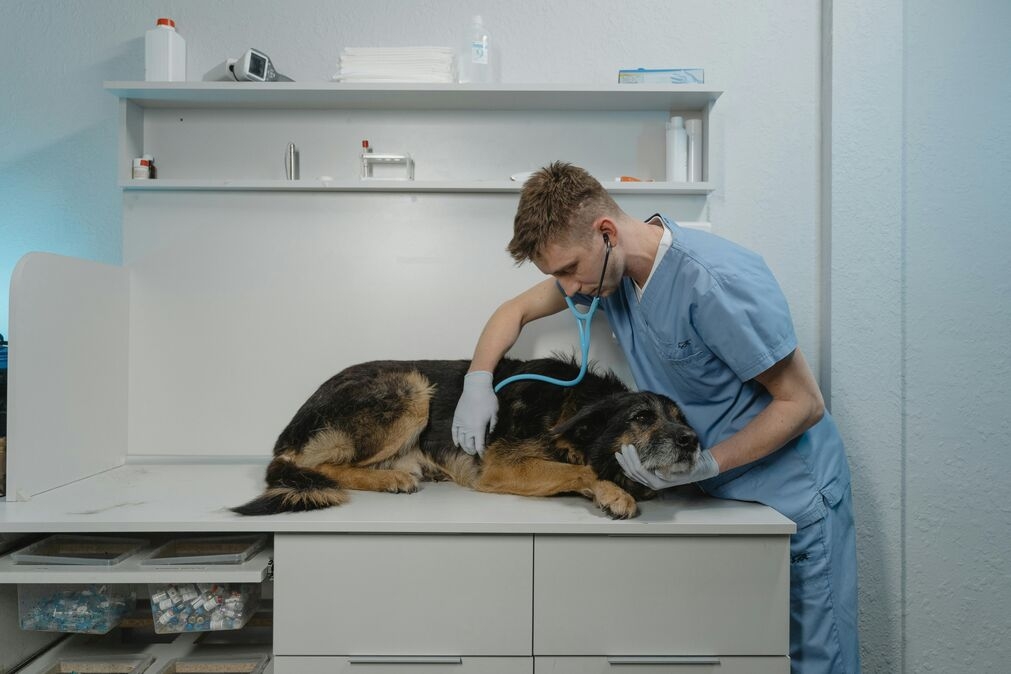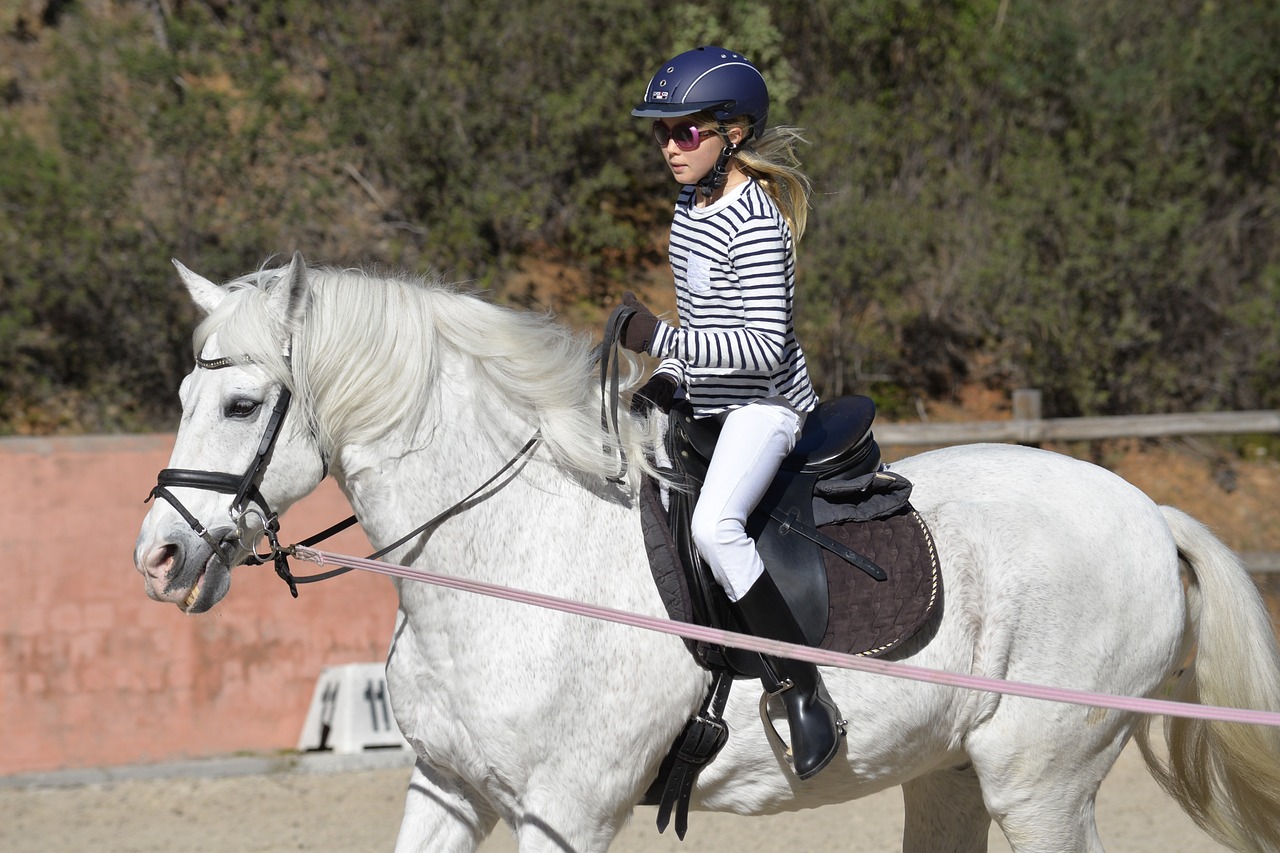Stray cats rub against your legs as a way to mark you with their scent, claiming you as part of their territory, and to establish a social connection, showing affection and trust.
Here are the most possible reasons,
- Marking Territory: Cats have scent glands on their cheeks, forehead, and the base of their tail. When a cat rubs against you, they are marking you with their scent.
- Social Bonding: Cats have social structures and can form bonds with humans. Rubbing against you is a way for a cat to show affection and establish a social connection.
- Communication: Cats communicate through scent. When a cat rubs against you, they are leaving their scent on you.
- Grooming and Affection: Cats groom each other as a sign of affection. When a cat rubs against you, it might be a way of mimicking this behavior.
- Temperature Regulation: Cats have scent glands on their face, and by rubbing against you, they may be distributing their scent while also picking up your scent.
- Seeking Attention: Cats may rub against you to get your attention. They may want to be petted, played with, or simply acknowledged.
Communication Through Scent
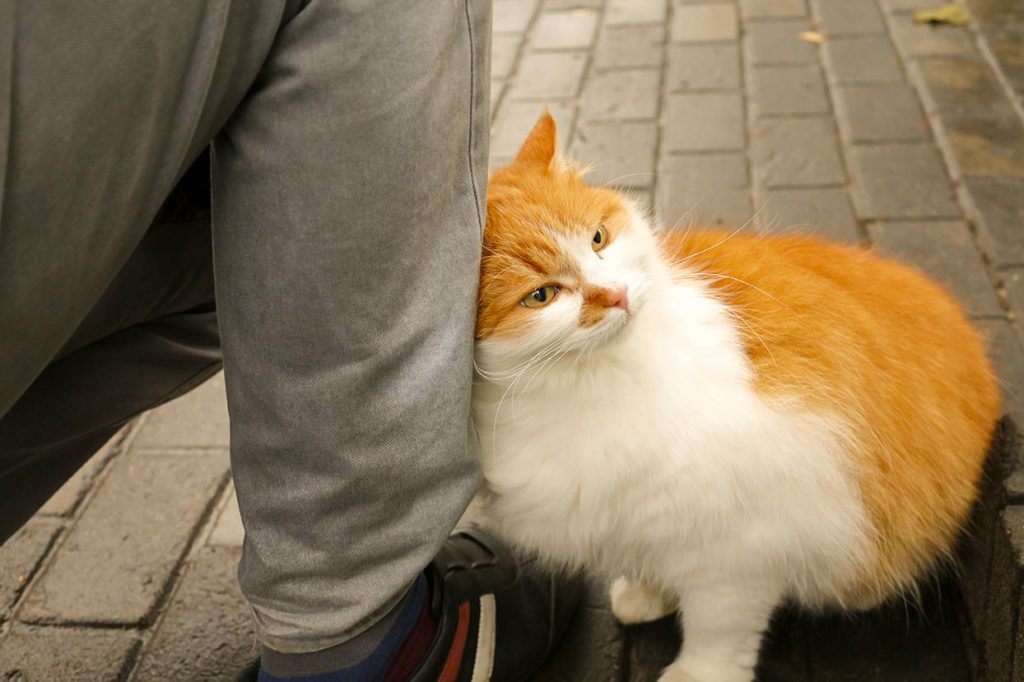
Scent Glands on Faces and Bodies:
Cats possess scent glands distributed across various areas of their bodies, with noticeable concentrations on their facial regions.
These glands secrete pheromones, chemical substances that play a crucial role in feline communication. The primary areas with scent glands include:
Cheeks: Cats have smelly skin spots, also called cheek glands. When a cat rubs its face against an object or a person, it is depositing these pheromones as a form of communication.
Forehead: The forehead is another area with scent glands. Cats may engage in head bunting, gently bumping their foreheads against objects or individuals, leaving their scent behind.
Chin and Jaw: Scent glands are also present on the chin and jaw. Cats might rub their chin against surfaces or people to mark their territory and convey information to other cats.
Paws: While not as prominent, scent glands are also found on a cat’s paws. Kneading, scratching, or walking on a surface can transfer these scent markings.
Rubbing Against Legs to Mark Territory:
Cats often engage in a behavior known as “bunting” or “head bunting,” where they rub their faces, particularly around the cheek and forehead areas, against objects or individuals.
When a cat rubs against your legs, furniture, or other items, it is depositing its scent as a way to mark its territory and establish a familiar environment. This behavior serves several purposes:
- Social Bonding: Head bunting can also be a sign of affection and social bonding. Cats may engage in this behavior with their owners or with other cats they feel comfortable with.
- Communication: The pheromones deposited during rubbing carry information about the cat’s identity, status, and emotional state. Other cats can interpret these scents and adjust their behavior accordingly.
Scent Communication in Social Interactions:
Scent plays a crucial role in the social dynamics of cat communities. Cats use scent to convey various messages, including:
- Status and Hierarchy: Dominant cats may use scent marking to establish and maintain their status within a group. Submissive cats may use scent to acknowledge the dominant cat’s authority.
- Mating Signals: During the breeding season, female cats may release pheromones to attract male cats. Scent communication is a key element in the reproductive behavior of cats.
- Emotional State: Cats can leave scent marks that convey their emotional state, helping other cats understand whether they are in a playful, relaxed, or stressed mood.
Seeking Affection and Attention
Social Nature of Cats and Desire for Human Interaction:
Contrary to the popular misconception that cats are aloof or independent, they are inherently social animals. While their social structure may differ from that of dogs, cats form strong bonds with their human companions.
They seek social interaction, companionship, and positive engagement. Cats often demonstrate a desire for human attention through various behaviors, and understanding these cues is crucial for fostering a strong human-cat bond.
Rubbing as a Form of Seeking Attention and Affection:
Cat rubbing is a common behavior through which cats desire attention and affection.
When a cat rubs against a person, they are engaging in a behavior known as “bunting” or “head bunting.”
This action involves the cat gently pressing or rubbing its face, particularly around the cheeks and forehead, against the person.
- Affectionate Gesture: When cats nuzzle or bump their heads against you, it’s a way of showing love and trust. They have smelly spots on their faces, and when they rub on you, it means they’re not just leaving their smell but also feeling cozy and close to you.
- Bonding: Cats may engage in head bunting as a way to strengthen their bond with their human companions. The act of sharing scents is a mutual and reassuring behavior that reinforces the connection between the cat and the person.
- Communication of Needs: Rubbing against a person can also be a way for cats to communicate their needs, such as a desire for attention, petting, or play. It serves as a non-verbal cue that the cat is seeking positive interaction.
Positive Experiences with Humans Leading to Repeated Rubbing Behaviors:
Positive interactions with humans create a sense of security and comfort for cats, reinforcing their inclination to seek affection through rubbing.
When a cat receives attention, petting, or other forms of positive engagement in response to its rubbing behavior, it associates the act with favorable outcomes.
This positive reinforcement encourages the cat to repeat the behavior to continue the enjoyable interaction.
- Building Trust: Cats are more likely to engage in rubbing behaviors when they feel safe and trust their human companions. Positive experiences contribute to building this trust over time.
- Creating a Routine: Cats are creatures of habit, and if positive interactions become part of a routine, the cat is likely to seek out those interactions regularly.
This can include morning greetings, evening playtime, or simply sharing quiet moments together.
- Individual Preferences: Each cat is unique, and preferences for affectionate behaviors may vary. While some cats prefer head bunting, others show affection through kneading, purring, or other behaviors.
Comfort and Trust Building
Role of Rubbing as a Behavior to Establish Comfort and Trust:
Rubbing is a fundamental behavior in a cat’s repertoire that serves to establish comfort and trust in their environment.
When a cat rubs against people, objects, or other animals, it engages in scent marking, a natural instinct that plays a vital role in communication and establishing a secure space.
The act of rubbing contributes to comfort and trust building in the following ways:
- Scent Familiarity: Cats create a familiar and comforting environment
by leaving their scent through rubbing.
The smell details the cat, like who they are, how they feel, and that they’re around. This helps them claim their space, feel like it’s theirs, and feel safe.
- Territorial Signaling: Rubbing against surfaces is a way for cats to mark their territory. In a shared environment, such as a multi-cat household, this behavior helps establish boundaries and a hierarchy, contributing to a sense of order and predictability.
- Mutual Trust: When a cat rubs against a person, it signifies a level of trust and comfort. The cat is willing to share its scent with the individual, indicating that it feels secure in the person’s presence.
Stray Cats Using Rubbing to Signal Safety in an Environment:
Stray or feral cats may heavily rely on rubbing behaviors to signal a sense of safety and comfort in a particular environment, especially if they are navigating unfamiliar territories. This behavior is observed in various ways:
- Marking Safe Spots: Stray cats may rub against objects, structures, or even other animals in an area they consider safe.
This establishes a familiar scent, marking locations where they feel secure and reducing the likelihood of confrontation with potential threats.
- Communication with Other Cats: In environments with multiple stray cats, rubbing serves as a non-aggressive form of communication. It helps in establishing a hierarchy, reducing tension, and promoting coexistence.
- Navigating Shared Spaces: Stray cats may use rubbing to navigate shared spaces, such as places where they find food or shelter.
This behavior allows them to leave their scent as a marker, informing other cats about their presence and activities.
Significance of a Cat Choosing to Engage in this Behavior with a Person:
When a cat chooses to engage in rubbing behavior with a person, it holds significant meaning in terms of the cat-human relationship:
- Trust and Affection: Choosing to rub against a person indicates that the cat feels a sense of trust and affection towards that individual. The cat willingly shares its scent, acknowledging the person as part of its social circle.
- Bond Strengthening: Rubbing is a bonding behavior. When a cat consistently engages in this behavior with a person, it strengthens their bond. This is particularly important in building a positive and trusting relationship.
- Emotional Security: The act of rubbing against a person suggests that the cat finds emotional security in their presence. The cat might be looking for comfort, reassurance, or just liking the good time with someone it trusts and finds supportive.
Individual Differences and Background
Recognition that Each Cat is Unique:
Like humans, cats have unique personalities, temperaments, and preferences. Recognizing and respecting these individual differences is crucial for understanding and effectively interacting with them.
Factors such as genetics, early life experiences, and socialization contribute to shaping a cat’s behavior and responses. Some key points regarding the uniqueness of each cat include:
- Personality Traits: Cats can exhibit a wide range of personality traits, from outgoing and affectionate to reserved and independent.
Understanding and appreciating these individual differences contribute to building a harmonious relationship.
- Communication Styles: Cats may express themselves differently, even within the same behavior.
For example, one cat might communicate affection through rubbing, while another may prefer purring, kneading, or other behaviors.
Influence of a Stray Cat’s Past Experiences with Humans on Comfort:
A stray cat’s past experiences with humans significantly shape their level of comfort and trust. Understanding the potential influences of their background is crucial for creating positive interactions:
- Positive Experiences: Stray cats that have had positive interactions with humans in the past may be more likely to approach people with trust and seek affection. Positive experiences can include receiving food, shelter, or gentle interactions.
- Negative Experiences: Cats that have had negative encounters with humans, such as abuse or neglect, may be more cautious or fearful.
These cats may take longer to build trust, and their comfort level may depend on the patience and understanding shown by individuals attempting to interact with them.
- Socialization Period: The age at which a stray cat is socialized with humans also influences their comfort level. Cats that were exposed to positive human interactions during their early socialization period are often more receptive to people.
Understanding Different Motivations for Rubbing:
While rubbing is a common behavior associated with affection and social bonding, it’s essential to recognize that cats may have different motivations for this behavior.
Each cat is an individual, and their reasons for rubbing may vary:
- Affection and Bonding: Many cats engage in rubbing as a way to express affection and strengthen their bond with humans. It is a positive and reassuring behavior that signifies trust and comfort.
- Territorial Marking: Rubbing is also a form of territorial marking, and some cats may rub to establish their presence and mark their territory. This behavior is not always driven by a desire for affection but rather by a natural instinct to claim a space.
- Communication of Needs: When cats rub against you, it could mean they want something like attention, playtime, or food. To figure out what they need, look at the situation and how the cat is acting.
Tips for Interacting with Stray Cats
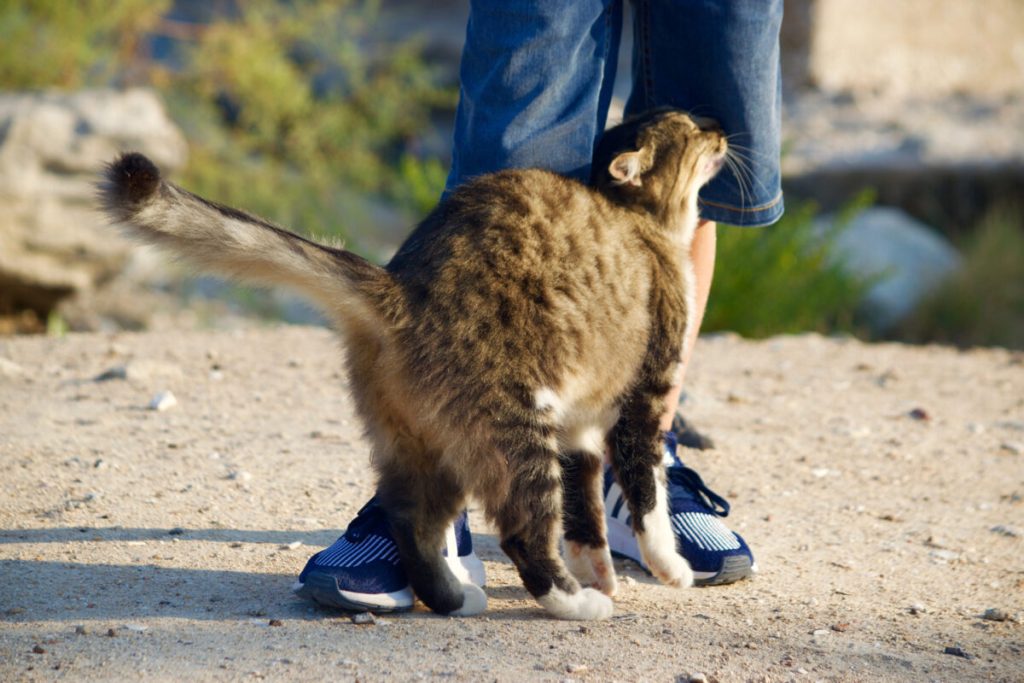
General Guidelines for Approaching and Interacting with Stray Cats:
Interacting with stray cats requires a careful and respectful approach to ensure the well-being of both the cat and the person. Here are some general guidelines:
- Approach Slowly and Calmly: Move slowly and avoid sudden movements. Speak in a calm and soothing voice to prevent startling the cat.
- Use Non-Threatening Body Language: Sit or crouch to appear less intimidating. Extend a hand slowly, allowing the cat to approach and sniff at its own pace.
- Avoid Cornering: Never try to corner or trap a stray cat. Always provide an escape route for the cat to feel more in control of the situation.
- Observe Body Language: Pay attention to the cat’s body language. If it shows signs of fear or discomfort (hissing, growling, arching back), back away and give it space.
Importance of Allowing the Cat to Initiate Contact:
Allowing the cat to take the lead in initiating contact is crucial for building trust and ensuring a positive interaction:
- Respectful Approach: Cats, especially strays, may be wary of human interactions due to past experiences. Allowing them to approach when they feel comfortable ensures a more positive and voluntary interaction.
- Building Trust: When a cat initiates contact, it indicates a level of trust and curiosity. This trust is essential for developing a bond over time.
- Reducing Stress: Feeling in control of the interaction with a stray cat reduces stress. Approaching at their pace helps them feel more secure and less threatened.
Promoting Positive Experiences to Build Trust Over Time:
Building trust with stray cats is a gradual process that requires patience and positive reinforcement:
- Consistent Presence: Spend time in the cat’s vicinity without direct interaction. This helps the cat become familiar with your presence and associate it with positive experiences.
- Offer Treats and Food: Use treats or food to create positive associations. Leave food near the cat and allow them to approach and eat without feeling pressured.
- Playful Interactions: Use toys to engage in gentle and non-threatening play with the cat. This helps them associate your presence with enjoyable activities.
- Respect Boundaries: Recognize and respect the cat’s boundaries. If the cat is not ready for direct contact, continue to provide positive experiences from a distance.
- Veterinary Care: Consider seeking veterinary care for the cat to address any health concerns. This improves their well-being and contributes to building trust as they associate you with care.
FAQs
Is it safe to let stray cats rub against me?
In most cases, allowing stray cats to rub against you is safe, but wash your hands afterward to minimize any potential health risks.
Do only stray cats exhibit this behavior?
No, both domesticated and stray cats may exhibit this behavior. It’s a common feline way of marking territory and expressing affection.
What does it mean if a stray cat repeatedly rubs against me?
Frequent rubbing can signify a stronger bond or trust. The cat may see you as a source of comfort, warmth, or even food, establishing a positive association.
Can I discourage stray cats from rubbing against me?
If you wish to avoid contact, you can gently deter the cat by calmly moving away. However, keep in mind that some cats may persist due to their social nature.
Is rubbing against the legs a sign of aggression in cats?
No, rubbing against legs is generally a friendly behavior, not a sign of aggression. Aggression in cats is more likely to be accompanied by hissing, growling, or defensive postures.
Can stray cats transmit diseases through rubbing?
While the risk exists, the transmission of diseases through casual contact is relatively low. Practicing good hygiene is crucial, especially if you have open wounds or scratches on your legs.
Do cats rub against their legs for warmth?
No, cats primarily rub against their legs as a form of scent marking and to establish territory, not for warmth.
Can I adopt a stray cat that rubs against me?
Yes, you can adopt a stray cat that shows signs of friendliness and affection, such as rubbing against you. However, before bringing the cat into your home, it’s important to ensure it is healthy.
Is it common for stray cats to form attachments to people?
Yes, it’s not uncommon for stray cats to form attachments to people who show them kindness and provide food. However, each cat’s behavior can vary based on its individual experiences and temperament.
Conclusion
To sum it up, it’s important to be gentle and respectful when dealing with stray cats. Just follow some basic rules, let the cat come to you, and make sure every interaction is positive.
Building trust takes time, so recognize each cat’s individuality, learn about their past, and respect their limits. Being patient, understanding, and caring about the cat’s well-being is crucial for creating a good and helpful connection.







